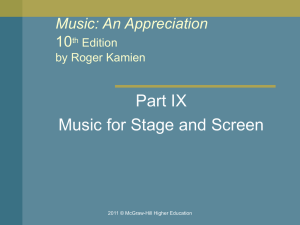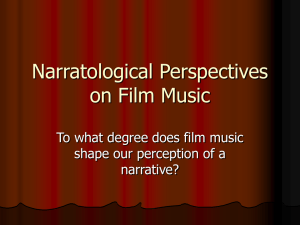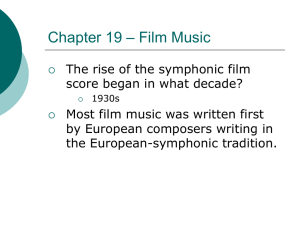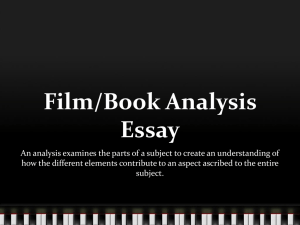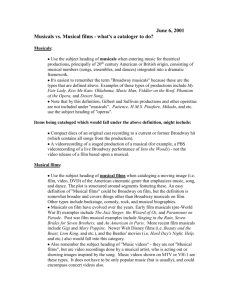Theater Arts B31 Chapter 5 - SOUND Lecture Notes
advertisement
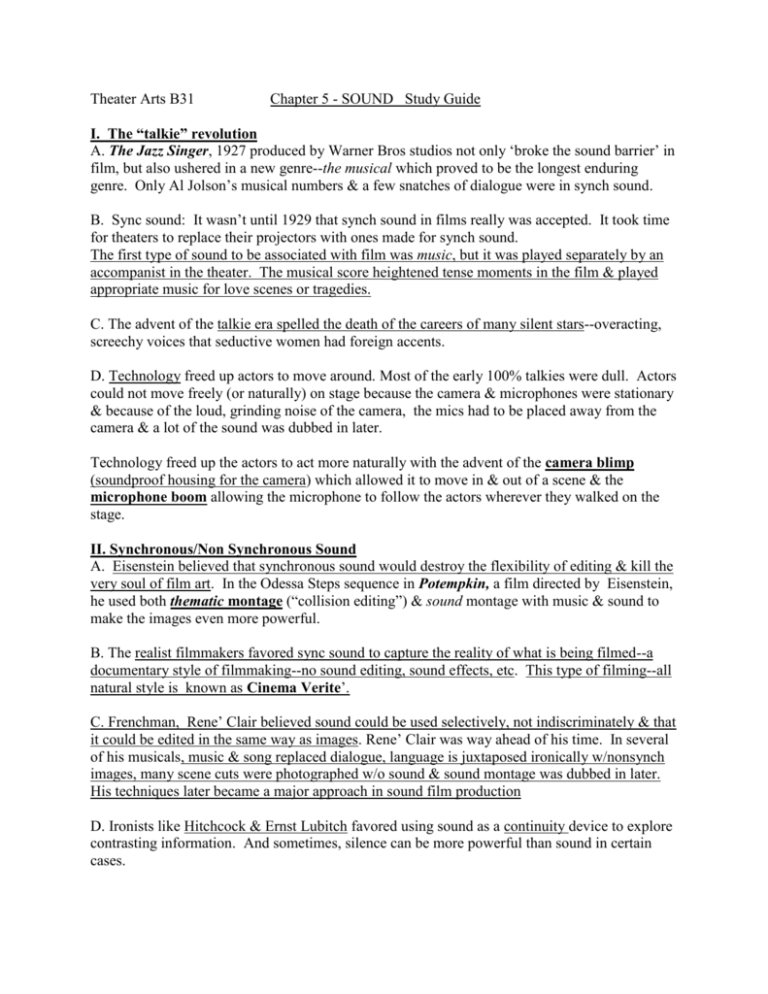
Theater Arts B31 Chapter 5 - SOUND Study Guide I. The “talkie” revolution A. The Jazz Singer, 1927 produced by Warner Bros studios not only ‘broke the sound barrier’ in film, but also ushered in a new genre--the musical which proved to be the longest enduring genre. Only Al Jolson’s musical numbers & a few snatches of dialogue were in synch sound. B. Sync sound: It wasn’t until 1929 that synch sound in films really was accepted. It took time for theaters to replace their projectors with ones made for synch sound. The first type of sound to be associated with film was music, but it was played separately by an accompanist in the theater. The musical score heightened tense moments in the film & played appropriate music for love scenes or tragedies. C. The advent of the talkie era spelled the death of the careers of many silent stars--overacting, screechy voices that seductive women had foreign accents. D. Technology freed up actors to move around. Most of the early 100% talkies were dull. Actors could not move freely (or naturally) on stage because the camera & microphones were stationary & because of the loud, grinding noise of the camera, the mics had to be placed away from the camera & a lot of the sound was dubbed in later. Technology freed up the actors to act more naturally with the advent of the camera blimp (soundproof housing for the camera) which allowed it to move in & out of a scene & the microphone boom allowing the microphone to follow the actors wherever they walked on the stage. II. Synchronous/Non Synchronous Sound A. Eisenstein believed that synchronous sound would destroy the flexibility of editing & kill the very soul of film art. In the Odessa Steps sequence in Potempkin, a film directed by Eisenstein, he used both thematic montage (“collision editing”) & sound montage with music & sound to make the images even more powerful. B. The realist filmmakers favored sync sound to capture the reality of what is being filmed--a documentary style of filmmaking--no sound editing, sound effects, etc. This type of filming--all natural style is known as Cinema Verite’. C. Frenchman, Rene’ Clair believed sound could be used selectively, not indiscriminately & that it could be edited in the same way as images. Rene’ Clair was way ahead of his time. In several of his musicals, music & song replaced dialogue, language is juxtaposed ironically w/nonsynch images, many scene cuts were photographed w/o sound & sound montage was dubbed in later. His techniques later became a major approach in sound film production D. Ironists like Hitchcock & Ernst Lubitch favored using sound as a continuity device to explore contrasting information. And sometimes, silence can be more powerful than sound in certain cases. Ch 5 Sound Study Guide III. Sound Montage 2 A. Orson Wells coming from the world of radio (War of the Worlds radio drama), was one of the greatest innovators in sound. In his film, The Magnificent Ambersons, he perfected the technique of sound montage. The ‘language’ wasn’t necessarily exploited for the literal information, but as pure sound orchestrated in terms of emotional tonalities. (walking through cafeteria, swap meet, the mall). We catch only a fleeting phrase here & there. It’s more like sound as it’s actually heard in reality. Later, Robert Altman used sound montage techniques in M.A.S.H. & Nashville, McCabe & Mrs Miller. It’s a common technique in film now. IV. Sound effects although the function of sound effects is primarily atmospheric, they can also be precise sources of meaning in film. A. High pitched sounds, including music, are generally strident & produce a sense of tension in the listener. --especially if these types of noises are prolonged, the shrillness can be unnerving. High pitches sounds are often used in suspense sequences, particularly just before & during the climax. B. Lower frequency tones are heavy & less tense.--more often used to emphasize the dignity or solemnity of a scene. Low pitched sounds can also suggest anxiety & mystery. Frequently a suspense sequence will begin with such sounds (The Shining--crane shot of car driving up Sidewinder). C. Sound volume works much in the same way-1. Loud sounds tend to be forceful, intense & threatening. 2. Quiet sounds strike us as delicate, hesitant & often weak. 3. These same principles apply to tempo. The faster the sound, the greater the tension. (Againin The Shining the climax scene where Nicholson is chasing Danny through the snowy maze). D. Off screen sounds expands the image beyond the confines of the frame. If it is an interior shot & a car pulls up, screeches to a halt & a car door closes, the world exists beyond the frame. Off screen sounds can evoke fear in suspense films & thrillers--The sound of something unseen can sometimes be more frightening than the actual image--we fear what we can’t see. E. Sound Motifs In Hitchcock’s Psycho, Bernard Herrmann’s score consisted entirely of strings--suggests shrill bird noises. This motif was used as a form of characterization--- Anthony Perkins--sharp features, hawk-like nose, was a taxidermist, liked to stuff birds, stuffed his own mum after she died. During the brutal murder sequence (Janet Leigh in the shower), the soundtrack throbs with screeching bird music. F. Sound effects can also express internal emotions Ch 5-Sound Study Guide 3 G. Like absolute stasis in a shot, absolute silence in a sound film tends to call attention to itself. Any significant stretch of silence creates an eerie vacuums--a sense of something impending, about to burst. Examples: Bonnie & Clyde & The Godfather I H. *Like the freeze frame, silence in a sound film can be used to symbolize death--sound represents ongoing life. Images tend to dominate sound, so many sound effects work on a subconscious level which serves as a symbolic function. V. The final scene from a movie is often the most important. Because of its privileged position, it can represent the filmmaker’s summing up the significance of the previous scenes--ie: The Shining--the long, slow zoom into the photograph on the wall --Outlook Lodge, July 4, 1921 with Jack Nicholson in the (lower) center of the picture.--He was *always* the caretaker. VI. Music A. Beginning with the opening credits, music can serve as a kind of overture to suggest the mood or spirit of the film as a whole--bouncy banjo music, western film, possibly a comedy. Certain kinds of music can suggest locales, classes or ethnic groups B. Music can be used as foreshadowing--particularly when a dramatic context doesn’t allow the director to prepare the audience or an event. C. Mickeymousing is purely descriptive music (so named because of Disney’s experiments in animation). Each note is a literal equivalent to the image (Wolf sneaking off) D. Modern atonal & dissonant music (discordant) generally evokes a sense of anxiety in listeners. This type of music doesn’t seem to have a melodic line & can even resemble a series of random noises (The Shining) E. Music can also be used to signify internal emotional shifts. F. Music can also provide ironic contrast G. Characterization can be suggested through musical motifs Stanley Kubrick was a bold, controversial innovator in the use of film music The extreme popularity of Star Wars revived the tradition of large-scale symphonic accompaniments to heighten the dramatic impact of scenes. Epic films usually have such a musical sound track. Both words & music convey meanings, but each in a different way. With our without lyrics, music an be more specific when juxtaposed w/film images. CH 5 - Sound Study Guide 4. Musicals & operas: One of the most enduring & popular film genres is the musical whose principal elements are song & dance. Like opera & ballet, the narrative elements of a musical are usually pretexts for the production numbers--some are dramatically sophisticated. Musicals can be divided into realistic & formalistic/expressionistic. Realistic musicals are generally ‘backstage stories’ in which the production numbers are presented as ‘dramatically plausible’. The narrative events would hold up ‘without’ the musical numbers. Formalist musicals make no pretense at realism. Characters burst out in song & dance in the middle of a scene without easing into the number with a plausible pretext. In the 1930’s, several major studios specialized in a particular type of musical: RKO produced the charming Fred Astaire-Ginger Rogers vehicles such as Top Hat. Paramount specialized in sophisticated ‘continental’ musicals like Lubitch’s Monte Carlo. At Warner Bros, Busby Berkeley delighted audiences with his proletarian show- biz stories like Gold Diggers, 1933. Berkeley’s stylistic signature is his fondness for abstract geometrical patterns (created on the optical printer) & photography of dancers from unconventional angles (angles an audience in the theater would never see--ie: overhead) to suggest a kaleidoscopic effect (All That Jazz--feather fans). The 1940s-50s musicals were dominated by MGM which had the finest musical directors under contract: Gene Kelly, Stanley Donen, Vincent Minelli & had a monopoly on the musical personalities of the day--Garland, Kelly, Frank Sinatra, Mickey Rooney, Ann Miller, Vera Ellen Leslie Caron, Donald O’Connor Cyd Charisse, Howard Keel, Mario Lanza, Kathryn Grayson & others. MGM also lured away Astaire, Pan & Berkely who with Michael Kidd, Bob Fosse, Gower Champioin & Kelly created most of the choreographies for the studio. Combining music & drama is a practice dating back at least to ancient Greece. No other medium excels the expressive range of the cinema. The stage has no equivalent to the musical documentary. Movie musicals can take the form of animated fantasies such as the Disney features Bambi & Dumbo. Musical biographies like Amadeus & The Buddy Holly Story, La Bamba (Ritchie Valenz) are commonplace in film. Two examples of great musicals created *directly* for the screen are Singin’ in the Rain & The Band Wagon. The cinema is also an ideal operatic medium--Ingmar Bergman’s The Magic Flute & Joseph Losey’s Don Giovanni (Mozart’s two greatest operas). Only a handful of operatic films approach major stature, perhaps because only a handful of major filmmakers have been attracted to the subgenre. Ch 5 -Sound Study Guide 5. Spoken Language is steeped with ideology. It’s an instant revealer of class, education, and cultural bias. The subtext refers to those implied meanings behind the language of a film or play script rather than the literal meaning. Monologue and dialogue Movies contain two types of spoken language: the monologue & dialogue. Monologues are often associated w/documentaries, in which an off-screen narrator provides the audience w/factual information, accompanying the visuals. Cinema Verite has extended this technique to include interviews. Instead of an anonymous narrator, he is shown interviewing subjects conveying their actual words. Monologues have also been used in fiction films. This technique is used omnisciently to provide an ironic contrast w/the visuals (Babe) Off screen narration tends to give a movie a sense of objectivity & often an air of predestination. In a film using flashback w/a narrator, the main interest is not what happened, but how & why. The Interior monologue is one of the most valuable tools of filmmaking for it can convey what a character is ‘thinking’. Dubbing versus subtitles Foreign language films are shown either in dubbed versions or in their original language w/subtitles. Voice over is nonsynchronous spoken commentary in a movie, often used to convey a character’s thoughts or memories. It can be a monologue/commentary or internal monologue. A voice over omniscient commentator can move the story along & refer to what various characters are thinking. Inflections of voice, idiom and dialect: Speech can reveal a person’s class, region, occupation, prejudices, etc, so the director doesn’t need to waste time establishing those facts visually. In films where the characters are highly educated, there is usually no foul language. Characters who are less or non-educated tend to use more foul language & characters such as gang members, gangsters, etc who are very violent , there is a steady torrent of foul language. “Personality voices”: James Cagney, Mae West, Edward G. Robinson
